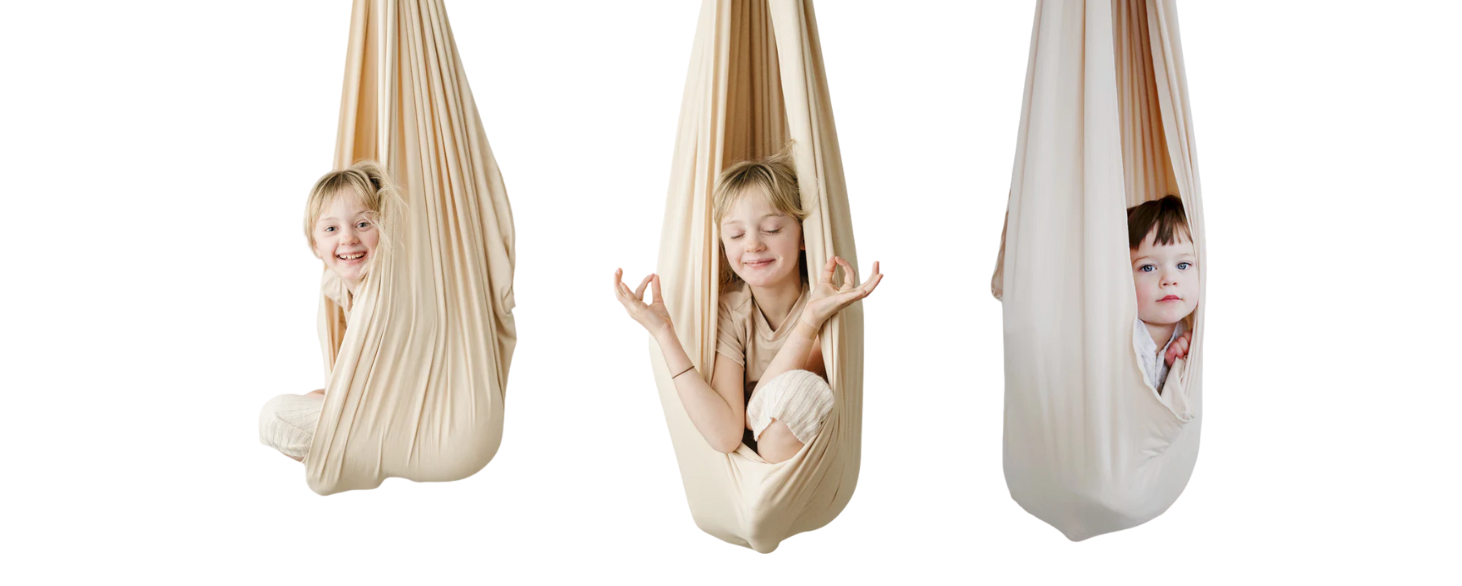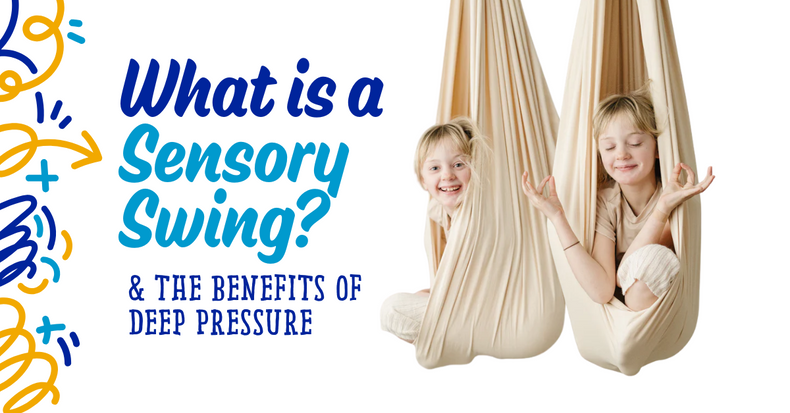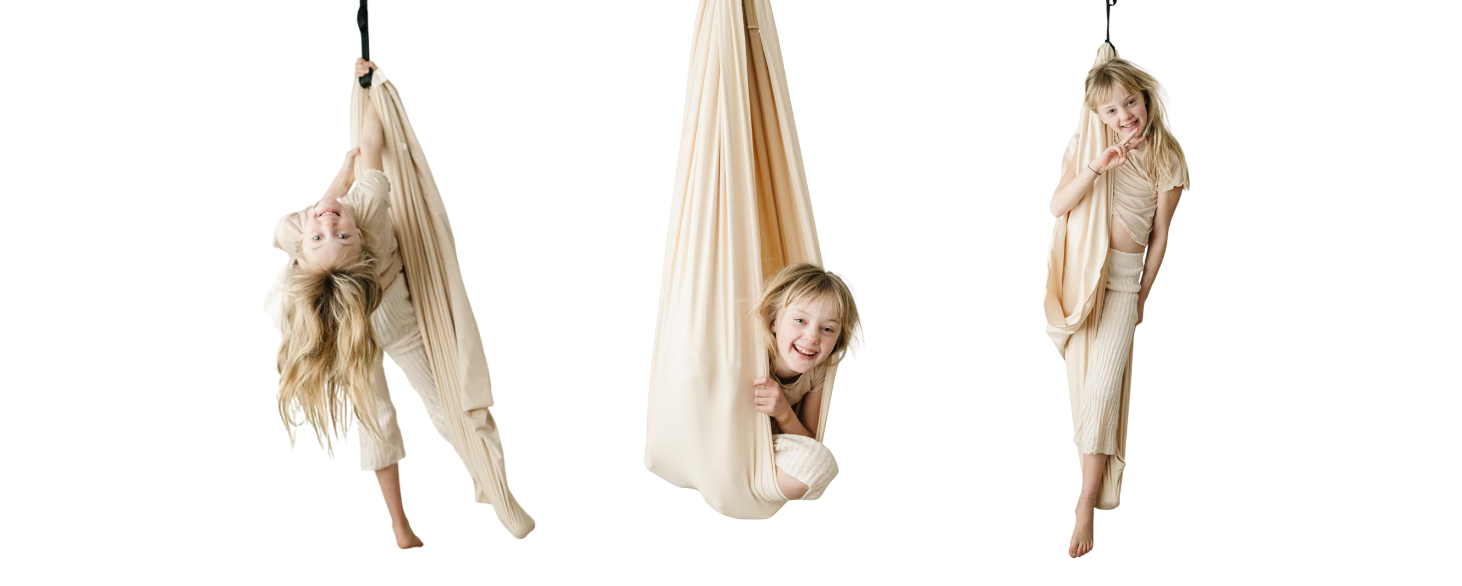Some children have trouble sitting still in class or staying calm during big feelings. Others crave movement but struggle to find appropriate ways to get it. Sensory swings provide gentle motion and comforting pressure that can help children regulate their bodies and emotions, making focus and learning easier.
Below is a clear look at how sensory swings work, what the research says about vestibular input and deep pressure, and simple ways to use them at home, school, or in therapy.
What is a Sensory Swing?
A sensory swing is a fabric cocoon or hammock that wraps around the user, providing both gentle swinging motion and deep pressure input. The combination of vestibular stimulation (from swinging) and proprioceptive input (from the fabric's gentle compression) creates a calming sensory experience that many children find soothing and organizing.
Sensory swings aren't a magic solution, and they aren't right for every child. Many families, teachers, and therapists use them as one tool in a broader sensory diet.

How Does Vestibular Input Help?
The vestibular system controls balance and spatial awareness. When children swing, rock, or spin, they activate this system, which sends organizing signals to the brain. Research shows that controlled vestibular input can improve attention, reduce anxiety, and support emotional regulation for many children, especially those with sensory processing differences, ADHD, or autism.
Studies on movement-based interventions consistently show that rhythmic, predictable motion helps children feel more grounded and ready to learn. The back-and-forth motion of a sensory swing provides this type of organizing input in a gentle, controlled way.
What About Deep Pressure?
Deep pressure stimulation activates pressure receptors in muscles and joints, often leading to a calming response. The fabric of a sensory swing provides this input by gently hugging the user's body. Research on deep pressure tools shows decreased anxiety and improved emotional regulation for many users.
When children are less overwhelmed and more regulated, attention and learning naturally improve. Teachers and therapists often notice that students who use sensory swings before challenging tasks are more focused and less fidgety.
Explore Other AdaptStore Deep Pressure Tools ➤
Safety and Best Practices
A few simple guidelines keep sensory swings safe and effective.
Always supervise use. Children should never use a sensory swing without adult supervision. Proper installation and regular equipment checks are essential.
Start with short sessions. Begin with 10-15 minute sessions and observe your child's response. Some children benefit from daily use, while others prefer occasional sessions.
Install properly. Use only heavy-duty or included hardware rated for swinging equipment. When in doubt, consult a professional for installation.
Watch for overstimulation. While many children find swings calming, others may become overstimulated. Stop use if a child becomes agitated or shows signs of distress.
Simple Ways to Use Sensory Swings
Before homework or challenging tasks: A few minutes of gentle swinging can help children organize their nervous system and prepare for focus work.
During transitions: Some children use swings to calm down after school, before dinner, or during other daily transitions.
In therapy spaces: Occupational therapists often incorporate sensory swings into treatment sessions to support regulation and motor planning.
At bedtime: Gentle swinging before bed can be part of a calming nighttime routine for some children.
These approaches align with research on sensory integration and the way families describe using movement tools to support daily routines.
Sensory Swing Features to Look For
When choosing a sensory swing, consider these practical features:
Quality fabric: Look for durable, machine-washable materials that will hold up to regular use. Soft cotton blends provide comfort without overheating.
Proper sizing: The swing should accommodate your child's current size with room to grow. Weight limits and age recommendations help ensure safety.
Easy installation: Look for swings that come with proper hardware and clear instructions. Adjustable hanging systems let you customize the height.
Versatile design: A neutral color and simple design will fit into most home or classroom environments.
Our Pick for Home and School
Marlowe & Co. Cotton Sensory Swing
A thoughtfully designed swing that provides both gentle compression and soothing movement. Made from soft, machine-washable cotton in neutral colors that fit any space. Sized generously to accommodate children ages 3-12 and supports up to 200 pounds.
The swing comes with heavy-duty swivel hardware and adjustable daisy chain straps for safe, customizable installation. Many occupational therapists recommend this type of swing as part of a sensory diet for children who benefit from vestibular and proprioceptive input.
Bottom Line
Sensory swings provide a gentle way to support regulation through movement and pressure. The research on vestibular input and deep pressure shows clear benefits for many children, especially around attention and emotional control. Used safely and thoughtfully, sensory swings can be a valuable addition to home, classroom, or therapy sensory tools.
Every purchase at AdaptStore helps fund AdaptAbilities programs so more people living with disabilities can grow, succeed, and belong. Choosing sensory tools here stretches your impact beyond your household or classroom.


